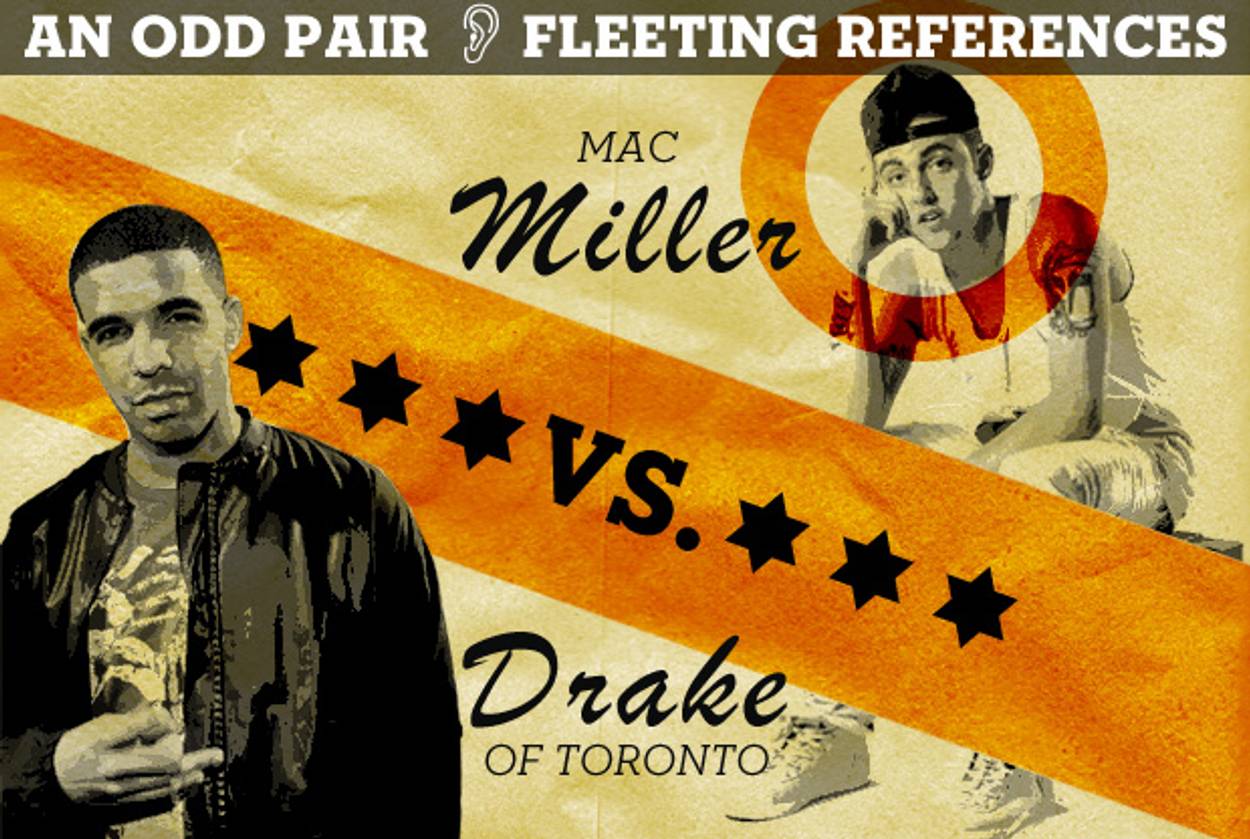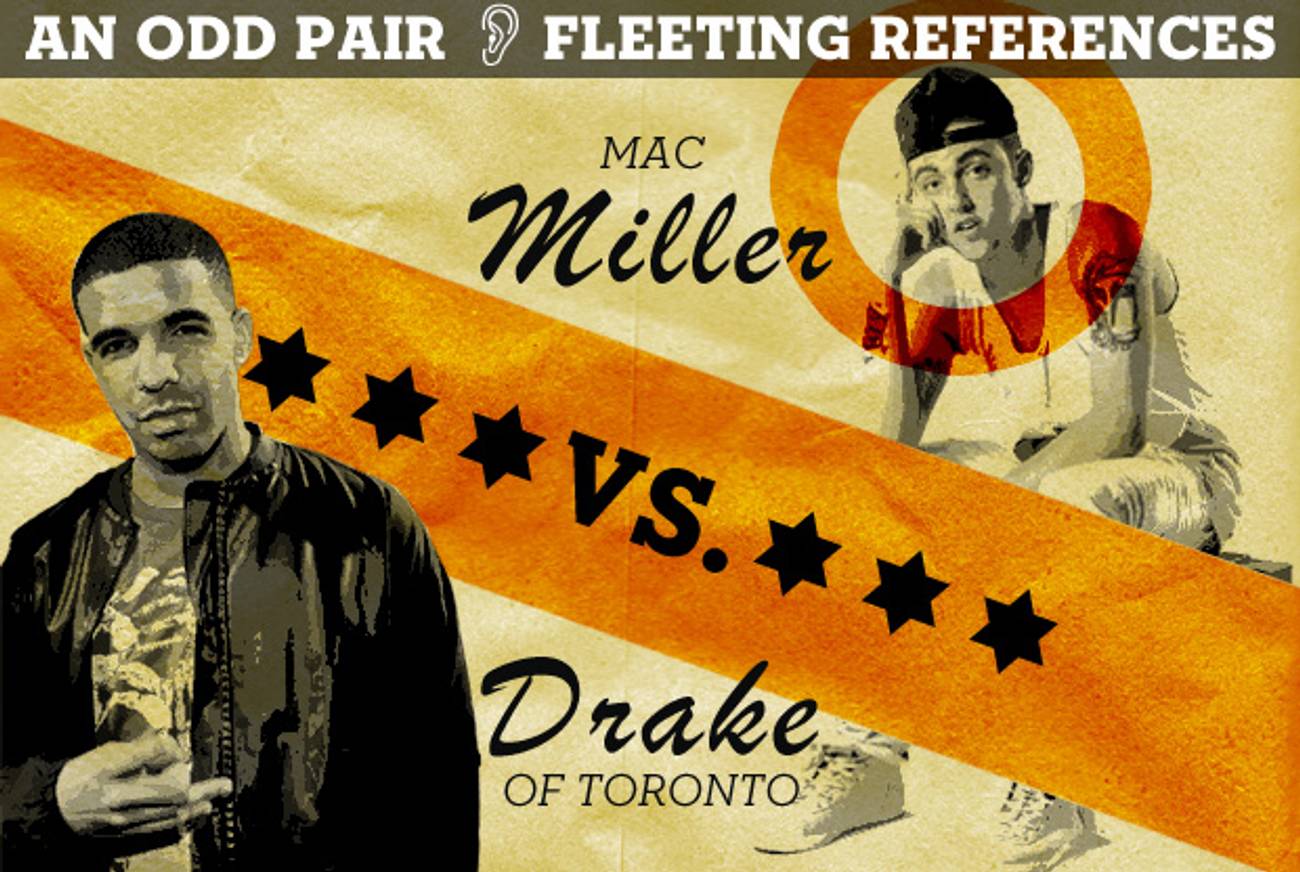Golden Boys
Jewish rappers Mac Miller and Drake are both at the top of the charts, but they’re at opposite sides of the music business




It might surprise you to learn that right now, as you read these words, you are living through the Golden Age of Jewish Rap. By which I mean that there are two popular rappers who are Jews, which is a 100 percent increase over last year’s total of one. As far as I can tell, there have never been two popular Jewish rap acts operating at the same time. You had the Beastie Boys, and then you had Drake, and now there’s Drake and Mac Miller, at the same time, together.
Beyond religion, there’s not much to compare. One’s a mixed-race Canadian rapper signed to the New Orleans label Young Money, which is run by Lil Wayne; the other is a 19-year-old white kid from Pittsburgh signed to his friend’s local label, Rostrum Records. Thanks to the now-fractured nature of music, the two have both been able to become fantastically successful without ever encountering each other on their journeys to the top. Drake, an oft-maligned but commercially and creatively successful prodigy of the Lil Wayne Star Academy, has been a fixture between the worlds of R&B and rap since his first single, “Best I Ever Had” dropped in 2009. That song was downloaded more than 2 million times and peaked at No. 2 on the Billboard Hot 100. Drake’s won BET Awards, should have won Grammys, and is nothing but a star, straddling a dozen markets like only a handful of contemporaries—Rick Ross, Kanye, Lil Wayne—can. He just released Take Care, only his second record, which is projected, by MTV anyway, to sell 725,000 copies.
In your other corner, you’ve got Mac Miller. Only 19, Miller has risen through a vastly different network. Given an entry point via fellow Pittsburgh rapper Wiz Khalifa, Miller’s march to success has been intertwined with social media, post-MySpace, and he’s played that game as well as anyone. Starting with 2010’s mixtape K.I.D.S, he’s been seen on singles charts, garnering a massive following on Facebook and Twitter. In a year, he went from 30,000 Facebook fans to 1.2 million, and those fans turned out to be the type who bought records. He released a mixtape called I Love You, Thank You to celebrate when he reached 1 million Twitter followers, and his Blue Slide Park has sold 144,000 copies, making it last week’s No. 1 album in America.
Miller’s music is entirely different then Drake’s; his songs are consistently earnest attempts at partying with the occasional choral keyboard beats like in his first hit, “Donald Trump.” It’s “Frat Rap,” a genre that includes the music of contemporaries like Sam Adams, Hoodie Allen, and a dozen other rappers known only to select segments of the Internet population. He’s the kind of songwriter who believes it’s charming to say how successful you are, and to describe your success vaguely enough that someone could apply anything you say to nearly any situation.
Miller is all about the rise, a seemingly never-ending quest that flows through nearly every song he’s recorded, certainly every song on Blue Slide Park. The constant striving seems to fit with the ever-expanding number of social followers, the ability to chart his own growth numerically, one follower at a time. On “Party on Fifth Ave,” far and away Slide Park’s best track, Miller uses electronic beats and mixes soul samples, as Drake does on Take Care, but he filters them down to their lightest elements. Most of Miller’s other tracks are so light they’re practically weightless, bouncing off each other with a joyful abandon that can quickly become tiresome. He’s said that he’s wanted to “appeal to hip-hop heads and people who grew up listening to the Beatles, Led Zeppelin and the Sex Pistols,” although there is nothing on this album that would lead you to believe he had ever heard a single track off of Never Mind the Bollocks, let alone Houses of the Holy.
Drake, on the other hand, has been propelled by people like West and Wayne into creating Take Care, a record so momentous it feels like it could transform an entire genre. Since 2003, with Kanye’s “Slow Jamz,” a certain segment of rap has been undergoing a Marvin-ification, combining modern electronic beats with the soul instrumentals of Marvin Gaye and Luther Vandross, with violins and choral voices layered on top. A bookend to West’s masterpiece My Beautiful Dark Twisted Fantasy, Drake’s latest is a massive leap forward for an already talented artist. Drake successfully combines Gaye and rap, but he has chosen the least-known version of Gaye, the depressed and deeply personal Marvin of Here, My Dear.
An album chronicling an excoriating divorce, Here, My Dear shows the pain of a man pushed to the edge by his own weaknesses and celebrity. Even though, as far as we know, Drake hasn’t suffered any pain similar or equivalent to Gaye’s, his Take Care works because it feels so honest and raw. On a track rightly titled “Marvin’s Room,” he recounts drunk-dialing an old girlfriend just to rub his success in her face and try to sleep with her, with no real resolution. Heavy drums and light electronic bloops play underneath, like a steady heartbeat, operating without any knowledge of what’s being said. He has collapsed in the song, needing any sort of validation, and it just drifts into an ending piano riff, lost in celebrity. Drake isn’t the first person to talk about such a situation, but he doesn’t ever break into anger, embracing but never seeming at home with fame. In “Lord Knows,” jumping off a lightening-strike of a soul sample, he steals a girl’s phone from her purse and talks about possibly becoming a new Bob Marley. Drake lets his confusion out, and he turns out to be just as sure of his own talent as he is unsure of everything else.
They’re an odd pair, these two Jewish Rap Stars. They both make fleeting references to their religion, with Miller dropping a Holocaust reference and Drake mentioning performing at bar mitzvahs. But Jewishness never seems to define or concern them. They seem equally earnest yet they never manage to mention a problem similar to the other’s, despite coming from similar socio-economic backgrounds and cities with the same chips on their shoulders, Pittsburgh and Toronto. They’ve used completely different means to attain the same wattage, with completely different audiences.
And that’s how the Jewish Golden Age of Rap is going to play out: divided, with its stars on opposite sides of the spectrum. It’d be a surprise to see either artist leaving the persona he has carved out, incessantly flirty partier or tortured playboy. It’d be easy to concede the trophy to Drake at this point, but Miller has room to grow. If there has to be a King of Frat Rap, let it be him, the one with the best flow and most energy. Take Care is a modern-day think piece, designed to poke and prod its creator while simultaneously appeasing his ego. Miller’s Blue Slide Park is a pretty bad album with occasional moments of hope, and is guaranteed to be a financial success. One for the soul, and one for the bank. Not bad, as far as golden ages go.
David Meir Grossman is a writer living in Brooklyn. His Twitter feed is @davidgross_man.
David Meir Grossman is a writer living in Brooklyn. His Twitter feed is @davidgross_man.